Lesson 17: Formatting Pictures
/en/powerpoint2013/inserting-pictures/content/
Introduction
There are a variety of ways to format the pictures in your slide show. The picture tools in PowerPoint make it easy to personalize and modify the images in interesting ways. PowerPoint allows you to change the picture style and shape, add a border, crop and compress pictures, add artistic effects, and more.
To crop an image:
When you crop an image, a part of the picture is removed. Cropping may be helpful when a picture has a lot of content and you want to focus on only part of it.
- Select the image you want to crop. The Format tab appears.
- On the Format tab, click the Crop command.
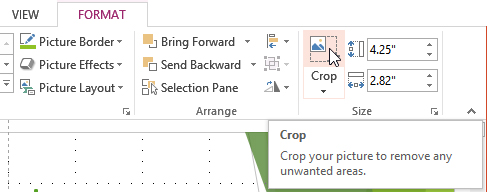 Clicking the Crop command
Clicking the Crop command - Cropping handles will appear around the image. Click, hold, and drag a handle to crop the image.
 Cropping an image
Cropping an image - Click the Crop command again. The image will be cropped.
The corner handles are useful for simultaneously cropping the image horizontally and vertically.
To crop an image to a shape:
- Select the image you want to crop, then click the Format tab.
- Click the Crop drop-down arrow. Hover the mouse over Crop to Shape, then select the desired shape from the drop-down menu that appears.
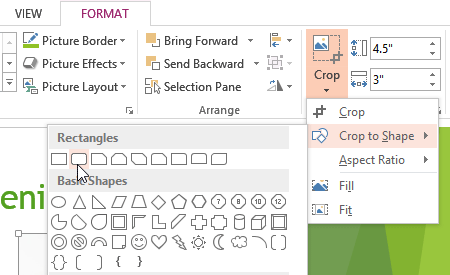 Selecting a shape
Selecting a shape - The image will appear formatted as the shape.
 The image cropped to a shape
The image cropped to a shape
You may want to crop the image to the desired size before cropping it to a shape.
To add a border to an image:
- Select the image you want to add border to, then click the Format tab.
- Click the Picture Border command. A drop-down menu will appear.
- From here, you can select a color, weight (thickness), and whether or not the line is dashed.
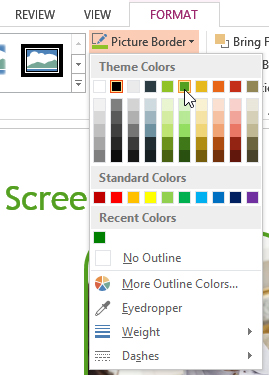 Changing the picture border
Changing the picture border
- The border will appear around the image.
 A picture with a green border
A picture with a green border
Image adjustments
PowerPoint offers several options for changing the way images appear in your slide show. For example, you can add a frame, make image corrections, change the image's color or brightness, and even add some stylish artistic effects. These options are located in the Adjust and Picture Styles groups on the Format tab.
 Image Adjustment Options
Image Adjustment OptionsWhen you're ready to make adjustments or experiment with the look of an image, select the picture and choose one of these options from the Format tab:
- Corrections: This command is located in the Adjust group. From here, you can sharpen or soften the image to adjust how blurry or clear it appears. You can also adjust the brightness and contrast, which controls how light or dark the picture appears.
 The Corrections command
The Corrections command - Color: This command is located in the Adjust group. From here, you can adjust the image's saturation (how vivid the colors are), tone (the temperature of the image, from cool to warm), and coloring (changing the overall color of the image).
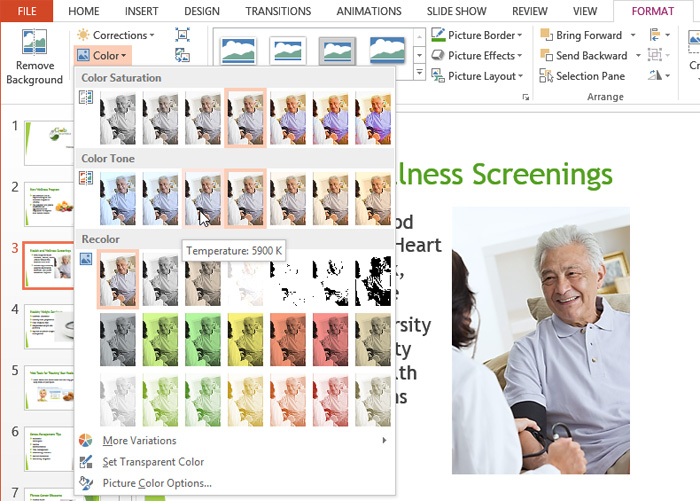 The Color command
The Color command - Artistic Effects: This command is located in the Adjust group. From here, you can add artistic effects such as pastels, watercolors, and glowing edges.
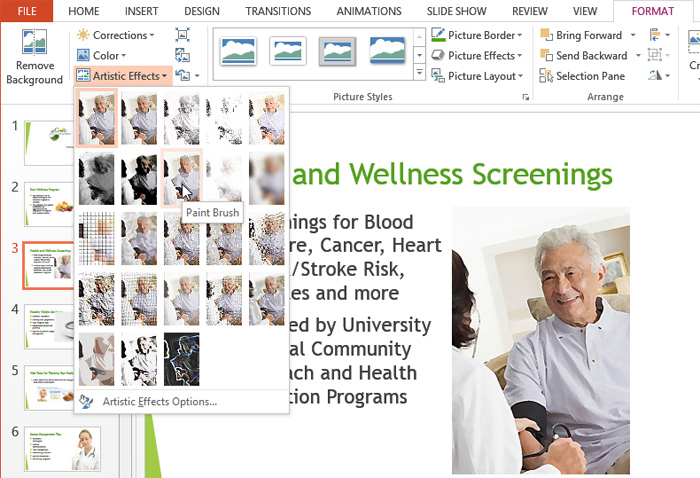 The Artistic Effects command
The Artistic Effects command - Picture Styles Group: This group contains a variety of styles you can apply to your picture, such as frames, borders, and soft edges.
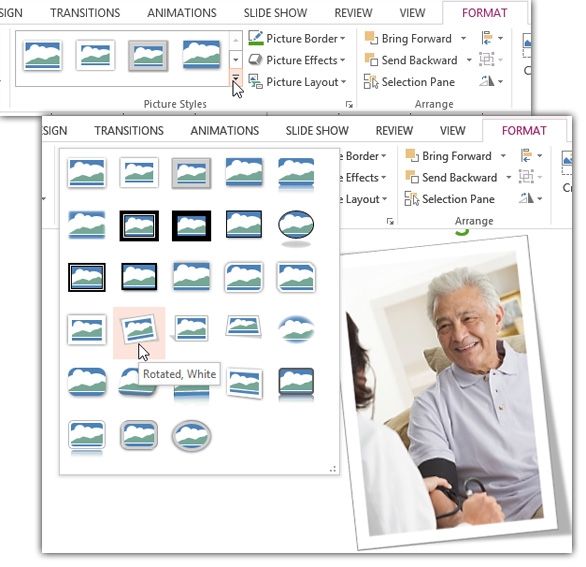 The Picture Styles drop-down menu
The Picture Styles drop-down menu
Compressing pictures
If you want to email a presentation that contains pictures, you'll need to monitor its file size. Large high-resolution pictures can quickly cause your presentation to become very large, which may make it difficult or impossible to attach to an email. Additionally, cropped areas of pictures are saved with the presentation by default, which can add to the file size. PowerPoint can reduce the file size by compressing pictures, lowering their resolution, and deleting cropped areas.
To compress a picture:
- Select the picture you want to compress, then click the Format tab.
- Click the Compress Pictures command.
 Clicking the Compress Pictures command
Clicking the Compress Pictures command - A dialog box will appear. Place a check mark next to Delete cropped areas of pictures. You can also choose whether to apply the settings to this picture only or to all pictures in the presentation.
- Choose a Target output. If you are emailing your presentation, you may want to select Email, which produces the smallest file size. When you are done, click OK.
 The Compress Pictures dialog box
The Compress Pictures dialog box
Removing the background from an image
With Background Removal, PowerPoint uses special algorithms to determine which parts of the image are the background and then removes these areas from the image. This can give your images a cleaner appearance and will allow the slide background (or other objects) to show through
Some images do not work as well with Background Removal, and they may require extra time and effort to get good results. Generally, it's more difficult if the image has a complex background or if the foreground and background blend together.
 Before
Before After
AfterTo remove the background from an image:
- Select the desired image, then click the Format tab.
- Click the Remove Background command.
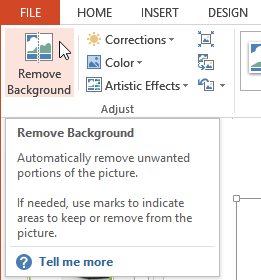 Clicking Remove Background
Clicking Remove Background - PowerPoint will try to guess which part of the image is the background, and it will mark this area with a magenta fill. It will also place a box around the image with selection handles.
 Background areas are marked with magenta
Background areas are marked with magenta - Drag the selection handles until all of the foreground is inside the box. After you do this, PowerPoint may readjust the background.
- At this point, you may need to help PowerPoint decide which parts of the image are foreground and which parts are background. You can do this by using the Mark Areas to Keep and Mark Areas to Remove commands:
- If PowerPoint has marked part of the foreground magenta, click Mark Areas to Keep and draw a line in that region of the image.
- If part of the background has not been marked with magenta, click Mark Areas to Remove and draw a line in that region of the image.
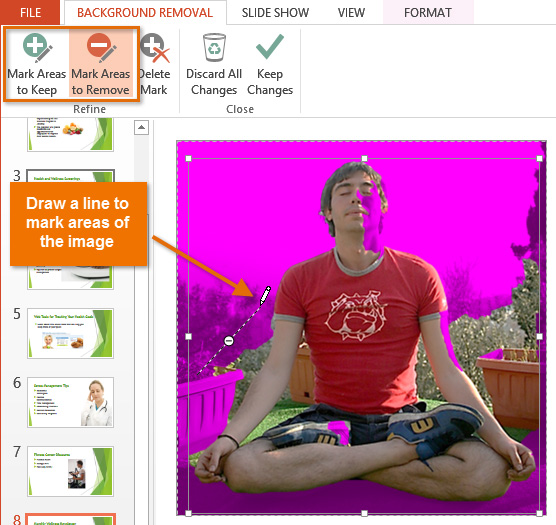 Marking areas to remove
Marking areas to remove - After you add your marks, PowerPoint will readjust the image.
 After adding marks
After adding marks - When you're satisfied with the image, click Keep Changes.
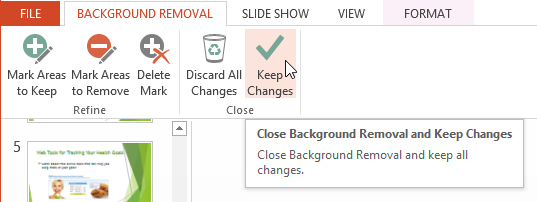 Clicking Keep Changes
Clicking Keep Changes - The background will be removed. You can adjust the image at any time by clicking the Remove Background command again.
 The finished image
The finished image
Challenge!
- Open an existing PowerPoint presentation. If you want, you can download our practice presentation.
- Resize an image. If you're using the example, use the image on slide 4.
- Remove the background from an image. If you're using the example, use the image on slide 6.
- Crop an image. If you are using the example, use the image on slide 4.
- Experiment with different image corrections and color settings.
- Add an artistic effect to an image.
- Try compressing an image.
/en/powerpoint2013/shapes-and-wordart/content/


 Clicking the Crop command
Clicking the Crop command Cropping an image
Cropping an image Selecting a shape
Selecting a shape The image cropped to a shape
The image cropped to a shape Changing the picture border
Changing the picture border A picture with a green border
A picture with a green border Image Adjustment Options
Image Adjustment Options The Corrections command
The Corrections command The Color command
The Color command The Artistic Effects command
The Artistic Effects command The Picture Styles drop-down menu
The Picture Styles drop-down menu Clicking the Compress Pictures command
Clicking the Compress Pictures command The Compress Pictures dialog box
The Compress Pictures dialog box Before
Before After
After Clicking Remove Background
Clicking Remove Background Background areas are marked with magenta
Background areas are marked with magenta Marking areas to remove
Marking areas to remove After adding marks
After adding marks Clicking Keep Changes
Clicking Keep Changes The finished image
The finished image